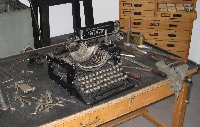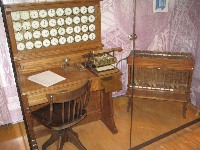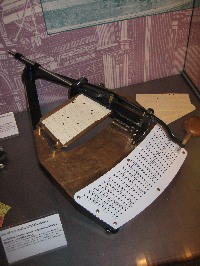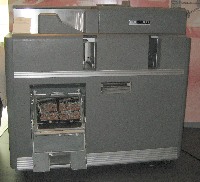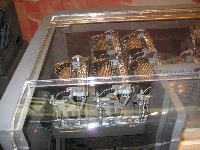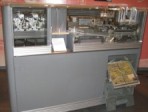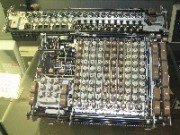Early Computers at Stanford
From Stanford CSD History
| Revision as of 01:11, 6 May 2010 Jsauter (Talk | contribs) move IMSS to right after Pine Hall ← Previous diff |
Revision as of 01:14, 6 May 2010 Jsauter (Talk | contribs) fold IMSSS section into Pine Hall Next diff → |
||
| Line 424: | Line 424: | ||
| It was used for Remote Job Entry to the big IBM iron which was in another | It was used for Remote Job Entry to the big IBM iron which was in another | ||
| building. | building. | ||
| - | |||
| - | ==Institute for Mathematical Studies in the Social Sciences (1977 to 1989)== | ||
| ===DEC PDP-10=== | ===DEC PDP-10=== | ||
| - | Mark Crispin remembers that there was a PDP-10 at IMSSS in 1977, | + | Mark Crispin remembers that there was a PDP-10 at |
| + | the Institute for Mathematical Studies in the Social Sciences | ||
| + | (IMSSS) in 1977, | ||
| using a KI10 processor and running the Tenex operating system. | using a KI10 processor and running the Tenex operating system. | ||
| At some point in the early 1980s, IMSSS acquired a second KI10 processor | At some point in the early 1980s, IMSSS acquired a second KI10 processor | ||
Revision as of 01:14, 6 May 2010
Created 15 August 1997, last updated May 5, 2010.
This is part of information collected for the Computer History Exhibits. Recent information.
Please send corrections and updates to Gio Wiederhold, email <[email protected]> and to John Sauter <John_Sauter at systemeyescomputerstore.com>.
The intent is to list all computers at Stanford up to about 1980, when personal computers became ubiquitous and uncountable. Some major, later equipment can be included.
Electronics Lab (1953 to 1962)
IBM CPC
In March of 1953 an IBM CPC arrived at the Electronics Lab. The CPC was composed of three IBM machines that had been made to work together: an IBM 604 or 605 calculating punch, an accounting machine (one of the IBM 400-series) and an IBM 941 auxiliary storage unit which held 16 10-digit signed numbers. Though marketed by IBM, the CPC was actually a combination developed by Northrop Aviation in 1948 for use in flight simulations and for other engineering work. It used mainly relays and some vacuum tubes.
Although it provided some storage, the IBM CPC was not a stored-program computer in the modern sense. The mechnical storage was similar to that of an IBM 602 machine. The CPC was programmable at three levels:
- The data paths between storage units in the accounting machine and the auxiliary storage units were determined by wiring.
- The electronic calculator in the IBM 604 or 605 could be micro-programmed using a plugboard in that unit, and
- The overall operation of the machine could be programmed using 80-column punch cards, each of which could perform two operations between three pieces of addressed data and store the result in the location specified in the fourth address. Cards were read at a rate of 100 cards per minute.
The IBM CPC was normally configured to do floating-point calculations.
Roger Moore remembers that this machine still existed at the Electronics Lab in 1961, when he was an undergraduate, though it was only used by students because the IBM 650 was much faster.
There was also an IBM CPC at Cornell.
In addition, Les Earnest used one from 1954 to 1956 in the Navy at the Aeronautical Computer lab in suburban Philadelphia, PA. It was from this experience that Les contributed much of the description above.
IBM 650
The first stored-program computer at the Electronics Lab was an IBM 650. It arrived in January of 1956 and was retired around 1962. This was a drum computer, meaning that the program and data resided on a rotating magnetic drum, rather than in random access memory (RAM) as used by later computers. The drum held 2000 10-digit words. An add instruction required 400 microseconds, and a multiply 10,000.
The IBM 650, like the IBM 604, used vacuum tubes. Later versions of the IBM 650, but not the machine at Stanford, had 60 words of core memory. They were intended to be used as an I/O buffer, but could also be used for instructions.
Here is a video showing an IBM 650 in use.
The IEEE Annals of the History of Computing has an article about the use of Stanford's IBM 650 in 1959 for computer dating: C. Stewart Gillmor, “Stanford, the IBM 650, and the First Trials of Computer Date Matching,” IEEE Annals of the History of Computing, vol. 29, no. 1, pp. 74-80, Jan-Mar, 2007. See also Computers in Love: Date Matching at Stanford from the Stanford Historical Society publication “Sandstone & Tile”, Summer/Fall 2002.
Roger Moore remembers that the machine was moved to Encina Hall at some point.
Encina Hall (1961 to about 1965)
Burroughs Datatron B220
There was a Burroughs Datatron B220 at Encina Hall starting in June of 1960. This was a vacuum-tube computer with originally 8,000 44-bit words of core, each containing 10 decimal digits and a sign digit. Core memory was a new technology, replacing drum memory with magnetic cores. This was called Random-Access Memory (RAM) because you could access any word of memory in the same time as any other word.
Because the sign was implemented as a digit instead of a single bit, a clever programmer could store extra information in the sign digits, since the add and subtract instructions used only the low-order bit of the sign digit.
Roger Moore remembers that this machine was upgraded from 8,000 to 10,000 words of core memory around 1960 or 1961. Roger also remembers the magnificant console of the B220, which Ted Glaser designed. It could be considered an ancestor of the touch-sensitive console. Each bit was made visible by a small neon bulb. There was a push switch under the bulb which could be used to invert the state of the bit. On the later Burroughs B5000, described below, the lamp and switch were integrated into a single unit.
The add instruction executed in 185 microseconds and multiply in about 2095. Roger Moore remembers that Case Institute developed an unapproved hardware modification which reduced the time to transfer data from memory to the D register from eleven cycles to four,
The B220 was shared with the First National Bank of San Jose, which used it for overnight check processing. An article In Datamation 7(12) dated December 1961 includes remarks by Professor George Forsythe about Balgol use at Stanford. We have not been able to find this article on-line, but the History of Programming Languages project has preserved an extract. Click on "Extract BALGOL" on the BALGOL page.
John Sauter remembers seeing the computer in the mid-1960s, and Roger Moore saw it in the fall of 1963, but we do not have a date for its retirement. The computer was programmed in Balgol, the Burroughs dialect of Algol-60.
Pine Hall (1961 to 1980)
Pine Hall was Stanford's “Computation Center” in the 1960s. The December 1961 issue of Datamation Magazine has articles describing the Stanford Computer Science Department as Pine Hall was opening. We have not been able to find this issue of Datamation on-line, but the History of Programming Languages project has preserved several of the articles. From the SUBALGOL page, click on “Extract: Balgol” and “Extract: Cutting Edge Computing at Stanford”.
Roger Moore remembers a subfloor flood in Pine Hall before any computers were installed. The cause was a sump pump failure.
Card Handling
The IBM 7090, the Burroughs B5000/B5500 and their successor, the IBM System/360 model 67, all described below, were batch-processing mainframes which read jobs from 80-column punch cards. To facilitate the preparation of card decks, there were several keypunches in Pine Hall. These keypunches were mostly IBM 026s, modified to include the additional characters used for Algol on the Burroughs B5000. We have been unable to find a record of the modifications made to the keypunches, or the resulting character set, but such custom keypunches were quite common at that time. Here is a video of an IBM 026 being demonstrated.
In addition to the keypunches there was some card-handling equipment known as “Electronic Accounting Machines”, or EAM in Pine Hall: an IBM 557 interpreter, an IBM 80-series card sorter (probably an IBM 083), an IBM 519 card reproducer and an IBM 407 printer with a card reader. The modified IBM 026 keypunches would print an image of each character at the top of the card, but the IBM 519 did not print, so it was customary to run a duplicated card deck through the IBM 557, which would print the first 60 columns at the top of each card in its first pass, and optionally print the remainder of the columns lower on the card on a second pass.
The IBM 407 was used to print a program's source code on paper. John Sauter remembers that the 407 made a strange sound as it was printing: it would print two lines in two cycles of the mechanism, and then take a third cycle in which it would not print. There was a simple, but forbidden, modification which would cause the IBM 407 to print on every cycle, increasing its speed from 100 lines per minute to 150. Roger Moore remembers why:
In the past, IBM had extended the market life of a mature card machine by renting a reduced-speed machine. This was accomplished by changing the pulley size on the main drive, and was done through the IBM 402. IBM had already announced the 2/3-speed 407 when the engineers discovered that the machine didn't work when the main shaft was slowed down. As the machine had already been announced, two extra relays were added which caused the IBM 407 model E8 to print two cards and then take a dummy cycle. It did have a distinctive sound because of this. The IBM 407 model E8 also had fewer co-selectors, pilot selectors and adders than the full model. IBM would charge for service if the relays were “damaged”. There was a gentleman's agreement with the IBM Customer Engineer that it was OK to remove one of the slow-down relays for a long job, provided it was re-installed before he noticed its absence.
Pictures of early data processing equipment
These pictures were taken in the Nixdorf Computer Museum in Paderborn, Germany. Click on the link following a picture for a larger image.
IBM 7090
The IBM 7090 was a fully transistor-based, room-size computer, with 32,768 36-bit words of core memory and a 2.18 microsecond cycle time. It performed an add instruction in 4.8 microseconds, and a multiply in typically 25 microseconds.
Visitors to Pine Hall could see the IBM 7090 through through a glass wall. Nearest the observer was the console, from which the operator could observe the machine's internal registers. At the back of the room was an IBM 1401, which provided card-to-tape and tape-to-print and -card punch services for the IBM 7090, which was therefore able to read its input from and write its output to magnetic tape. The two machines shared two rows of IBM 729 IV magnetic tape drives. Here is a video of a restored IBM 1401 in use.
The IBM 7090 was installed in Pine Hall in late 1962 or early 1963, and retired in May of 1967. Roger Moore remembers that from late spring 1962 until its move to Pine Hall, the IBM 7090 resided at IBM San Jose, where Stanford personnel were able to use it for eight hours every week day. In addition, the Subalgol project used it on weekends. After its installation in Pine Hall it continued to be used by IBM San Jose.
In its later years the IBM 7090 acquired an IBM 1301 disk, which it shared with the nearby DEC PDP-1, and a CDC 8090 was added to augment the IBM 1401.
A notable improvement in productivity was achieved when Stanford programmer Don Gold was able to make the IBM 1401 copy simultaneously from card reader to tape and from tape to printer and card punch. Previously, the IBM 1401 could copy in only one direction at a time.
The IBM 7090 provided general computer service to campus users, including the Artificial Intelligence project (Lisp and Chess). Classes were offered in programming the IBM 7090. The machine ran IBM's Fortran Monitor System, which automatically loaded the next job from magnetic tape when the previous one finished. In addition to Fortran and the FAP assembler, the IBM 7090 was programmed in SUBAlgol, the Stanford dialect of Balgol, which was the Burroughs dialect of Algol-60.
Burroughs B5000/B5500
The Burroughs B5000 was another fully-transistorized, room-size computer, installed in the room to the right of the IBM 7090 from the point of view of the observer looking through the glass wall.
This machine was based on advanced computer concepts for its day, as contrasted with the IBM 7090, which stressed compatibility with earlier IBM computers. It was installed before May of 1963, perhaps in 1961, and retired in 1968. It was upgraded to a Burroughs B5500, which ran at three times the speed of the B5000 and offered a second CPU. Due to software limitations, the second CPU could only execute in user-mode; an attempt to enter the operating system would cause it to signal the main CPU for attention.
The B5000 had 16,384 48-bit words of memory. It was programmed in Algol-60 with extensions for I/O and string processing. Late in its life the B5500 switched off its drum storage and used disks instead.
The Burroughs computer provided general computation service to the campus, including classes on Algol-60 and validation of Algol programs submitted for publication as algorithms.
John Ehrman remembers that until late 1966 there was a dial-up link from SLAC for submitting and retrieving B5500 jobs.
DEC PDP-1
The PDP-1 was to the left of the IBM 7090, but was not visible to observers, lacking a glass wall. This was a much smaller-scale computer than the IBM 7090, used for research in computer-based learning, artificial intelligence, and games. A time-sharing system was developed for the PDP-1, formally named the Stanford Time Sharing System, though it also went by the names Zeus and Odin. Time sharing allowed people at separate consoles to use the PDP-1 simultaneously, a great increase in productivity.
The PDP-1 arrived sometime before May of 1963. Early in its life it was upgraded from 4,096 18-bit words to 65,536. When the IBM 7090 acquired its IBM 1301 disk drive, the PDP-1 was interfaced to it through the IBM 7631 file control. The PDP-1 was also interfaced directly to the IBM 7090, and could submit jobs to it using the Bifrost software. This interface was also used to visualize IBM 7090 data in real time using the PDP-1's Type 30 CRT display. See [1] for an example. When the PDP-1 was retired, probably in 1966 or 1967, its Type 30 display was moved to the DEC PDP-6 at the Stanford Artificial Intelligence Lab.
In support of its time-sharing mission the PDP-1 was equipped with a high-speed magnetic drum, which could write 4,096 words of memory onto a track in one revolution, and simultaneously read 4,096 words from a different track and write them into those same memory locations. This was called “swapping”.
The PDP-1 also had twelve CRT displays built by Philco, affectionately called “flickos”. These terminals, combined with the drum and the time-sharing software, made the Stanford PDP-1 the first display-oriented time-sharing system anywhere in the world. It was used for a number of years for computer-aided instruction by Professor Patrick Suppes and his group.
At the beginning of his Computers and Education article on Computer-based mathematics instruction Professor Suppes describes the Stanford PDP-1.
John Sauter remembers a regrettable incident in which a failure in one of the displays caused a loud noise, severely frightening the child who was seated at it. John never learned how this traumatic experience affected the child's ability to deal with computers later in his life.
IBM System/360 model 67
In May of 1967 an IBM System/360 model 67 replaced the IBM 7090, Burroughs B5500 and DEC PDP-1 in Pine Hall. There is some question about whether this machine was a model 65 or model 67, but John Sauter remembers seeing the lights of the “Blaauw Box”, the dynamic address translation module that is the difference between the models. Also, Glen Herrmannsfeldt and John Ehrman remember that it was always described as a model 67. However, despite the dynamic relocaton capability, the model 67 was run as a model 65 using IBM's OS/360 MFT operating system.
The original development of WYLBUR and ORVYL were done on the model 67. John Sauter remembers a flyer featuring cartoon personages named Wylbur and Orvyl with the caption “My brothers communicate”. MILTEN was used to support remote users equipped with IBM 2741 terminals. SPIRES was also originally written on the model 67. Nicklaus Wirth developed PL360 and Algol W on the model 67; Algol W later evolved into Pascal.
The IBM System/360 model 67 had 524,288 8-bit bytes of memory. It could perform an add in 1.5 microseconds, a multiply in 6.
DECSYSTEM-20
Mark Crispin and Rich Alderson remember a DECSYSTEM-20, possibly named CONTEXT, at the computer center in the early 1980s. It was supposed to be used for editing and e-mail only.
DECSYSTEM-20
Mark Crispin remembers that the SCORE DECSYSTEM-20 was originally installed in Pine Hall in 1979 and moved to the Computer Science Department's then-new digs in Margaret Jacks Hall in 1980. There is more information about the computers in Margaret Jacks Hall below.
IBM System/360 model 30
Mark also remembers an IBM System/360 model 30 in Pine Hall at that time. It could perform an add in 29 microseconds, a multiply in 303. It was used for Remote Job Entry to the big IBM iron which was in another building.
DEC PDP-10
Mark Crispin remembers that there was a PDP-10 at the Institute for Mathematical Studies in the Social Sciences (IMSSS) in 1977, using a KI10 processor and running the Tenex operating system. At some point in the early 1980s, IMSSS acquired a second KI10 processor from Rutgers and became a dual KI10 system like SUMEX. Rich Alderson remembers this system still being in place in 1989.
Sil Sanders remembers that these machines were in Pine Hall, replacing the PDP-1. The first PDP-10 initially ran the TOPS-10 operating system provided by Digital Equipment Corporation. Later a BBN pager was added and the machine ran the Tenex operating system. When the second PDP-10 processor was added the BBN pager was upgraded and the Tenex operating system modified to support dual processors.
Most of that OS software work was done by Rainer Schultz. During that period they also added a Speech Synthesis unit called the MISS machine that Gerard Benbassat and Sil Sanders developed and built which was used in a computer-based logic course for undergraduates by Patrick Suppes and also with some language courses.
High Energy Physics Lab (early 1970s)
The building now known as the Hansen Experimental Physics Lab was known as the High Energy Physics Lab in the early 1970s.
IBM 7700
HEPL had an IBM 7700 Data Acquisition System with 16,384 18-bit words of memory for data acquisition from experiments. IBM seems to have only built two of these machines. The IBM 7700 was at the lab in the early 1970s.
One important outcome of HEPL was Professor Henry Kaplan's insight that a linear accelerator could be used for creating highly focused energy for radiological treatments. A brief history of the medical linear accelerator was published in 2007 on its 50th anniversary.
Stanford Artificial Intelligence Lab (1965 to 1979)
The Stanford Artiticial Intelligence Lab was housed in the former D.C. Power Laboratory beginning in 1965. See [2] and [3]
DEC PDP-6
The first computer installed at the Stanford Artificial Intelligence Lab was a DEC PDP-6, delivered in June of 1966. It had 65,536 36-bit words of core memory and used 8 Dectape drives for file storage. Later a high-speed Librascope disk was added for swapping. The Librascope could not be used for file storage because it was extremely temperature-sensitive. Les Earnest remembers that a one-degree change in room temperature was enough to make it start forgetting. To make it even reliable enough for swapping required making two copies and checksumming, so it was eventually shut down.
This computer system was primarily used for artificial intelligence research, including the programming languages LISP and SAIL, and for chess and checkers. There were three versions of the “robot arm”, used for research into manipulation.
DEC PDP-10
In 1968 the PDP-6 was augmented by a PDP-10 processor, the KA10, resulting in a dual-processor system. Memory was expanded from 65,536 to 196,608 36-bit words.
Later an IBM 2314 disk array was added for additional data storage. The time-sharing operating system written at SAIL, known as WAITS, was based on the PDP-6 Monitor, provided by Digital Equipment Corporation (DEC) rather than the Stanford Time-Sharing System which had been written for the PDP-1.
See [4].
Les Earnest remembers that the first and second spelling checkers for text files were developed at SAIL around 1967 and 1971. The first computer-controlled vending machine anywhere (called The Prancing Pony, from Tolkein's Lord of the Rings, a source of many place names at SAIL) was developed around 1972.
Beginning in 1971 the SAIL computer facility put bit-mapped displays on everyone's desk and was apparently the first facility to do this anywhere in the world. Those displays could also show live television either from cameras in the lab or from broadcast TV. At about this time Les Earnest developed first social networking program, Finger, and it included what amounted to a blog service, see [5].
Mark Crispin remembers that when he arrived in 1977 there were two processors in the PDP-10 system: the KA10 described above and a KL10, the fastest processor in the PDP-10 line. User jobs were run on the KL10 and the KA10 ran the XGP font compiler and user jobs (in “spacewar mode”, formerly the task of the PDP-6 processor).
Les Earnest remembers that the KL10 was a gift from DEC in return for the design concept, since it was based on the Super Foonly computer designed by Dave Poole, Phil Petit and Jack Holloway and was re-engineered by DEC using SUDS, the Stanford University Drawing System, which was the first interactive electronic CAD system and was also developed by the Super Foonly project.
The PDP-6 had by then become a separate computer, though it booted from the PDP-10. It operated the computer music devices. Rich Alderson remembers that it was retired in 1984.
Mark Crispin remembers having been told by Les Earnest that the KA10 was forcibly retired due to a combination of cooling failure and overtemperature sensor failure. Mark purchased the remains as scrap metal from Stanford surplus property and kept some parts as souvenirs.
Margaret Jacks Hall (1979 to 1983)
The Stanford Artificial Intelligence project moved to the basement of Margaret Jacks Hall in 1979.
DEC PDP-10
A DEC PDP-10 with a KL10 processor and 524,288 36-bit words of memory was installed there. This was the SAIL KL10 from the Stanford Artificial Intelligence Lab.
DECSYSTEM-2050
Mark Crispin remembers that SCORE, a consortium of the Computer Science Department, two Electrical Engineering laboratories and Operations Research, purchased a DECSYSTEM-2050 in 1979. It was first installed in Pine Hall and then moved to Margaret Jacks Hall.
DECSYSTEM-2060
When the Computer Science Department sold its interest in the SCORE system to its partners in 1983, the DECSYSTEM-2050 moved to Electrical Engineering and was renamed SUSHI. The Computer Science Department bought a new DECSYSTEM-2060 which had the first 4-RP07 public file system. Its great size, 887,685,120 36-bit words, astonished DEC Field Service.
Xerox Alto
In 1979 or 1980, 16 Xerox Alto workstations were installed in Margaret Jacks Hall along with two servers. Al Kossow remembers that the IFS file server was in the basement, and Les Earnest remembers that the Dover server was on the second floor, near the Computer Science Department's administrative offices. They featured a What-You-See-Is-What-You-Get (WYSIWYG) text editor, but the Smalltalk language was not provided.
Electrical Engineering (1983)
DECSYSTEM-2050
When the Computer Science Department sold its interest in the SCORE system to its partners in 1983, the DECSYSTEM-2050 moved to Electrical Engineering and was renamed SUSHI.
DECSYSTEM-2060
Rich Alderson remembers that there was also a DECSYSTEM-2060 at Electrical Engineering called SIERRA.
Stanford Linear Accelerator Center (1965 to 1981)
SDS Sigma 5
John Ehrman remembers that there was an SDS Sigma 5 in End Station A from at least 1965. It was used for data acquisition and control of the experimental equipment.
IBM System/360 model 50
SLAC ordered an IBM System/360 model 91 from IBM, and as a result received the slower but software-compatible System/360 model 50 in June of 1965. John Ehrman remembers that this machine was arranged by William Miller, who was later Provost of Stanford. The model 50 had 262,144 8-bit bytes of memory, and could perform an add in 4 microseconds, a multiply in 16. John Ehrman remembers that it initially ran TOS/360, then OS/360 PCP and then OS/360 MFT. The initial configuration used IBM 2311 disks, later upgraded to IBM 2314 disks.
IBM System/360 model 75
The model 50 was replaced by the model 75 with 1,048,576 8-bit bytes of memory in 1967. This machine could do an add in 0.75 microseconds and a multiply in 3. John Ehrman remembers that this machine ran OS/360 MVT.
IBM System/360 model 91
The model 91 arrived in 1968 and was retired August 21, 1981. It had 2,097,152 8-bit bytes of memory and could do an add in 0.2 microseconds, a multiply in 0.4. It was programmed primarily in Fortran. Ted Johnston remembers that this was the first machine at SLAC to run WYLBUR, around late 1969 or 1970, replacing Conversational Remote Batch Entry (CRBE), an IBM program.
IBM System/370 model 168
In late 1973 and early 1974, SLAC installed two IBM System/370 model 168s. Glen Herrmannsfeldt remembers that these computers each had 3,145,278 8-bit bytes of memory. Ted Johnston remembers one of them being upgraded to 5,242,880 and the other to 8,388,608 8-bit bytes by 1979. They were shut down in 1981 and 1982, their duties assumed by the IBM 3081.
John Ehrman remembers that these machines were arranged in a “Triplex” system under ASP with the model 91.
DEC VAX systems
John Ehrman remembers that VAX systems proliferated in some of the major research groups in the mid-1970s.
In the 1990s, China's Institute of High Energy Physics established a 9600 bits per second data connection between their VAX computers and the VAX computers at SLAC. This later grew into China's first Internet connection. For details, see this story in ComputerWorld.
IBM 3081
Ted Johnston remembers that when the model 91 was shut down in 1981 it was replaced by an IBM 3081 with 16,777,216 8-bit bytes of memory. Over a period of two years the IBM 3081 replaced all of the prior mainframes.
Stanford Medical School (1964 to about 1992)
DEC LINC
In the south wing of the basement of the Stanford Medical School, the Genetics Lab had a DEC/NIH LINC computer with 4,096 12-bit words in 1964.
IBM System/360 model 50
From December of 1965 until 1973 an IBM System/360 model 50 was the principal computer of ACME. It had 131,072 8-bit bytes of memory plus an extension that provided 1,048,576 (later 2,097,152) additional bytes of lower-speed memory. This system had an IBM 2321 data cell drive, holding tape strips, giving the huge capacity (for the time) of about 400,000,000 8-bit bytes. This device was famous for its unreliability.
The model 50 also had four IBM 2311 disk drives, at about 7,250,000 8-bit bytes each, later replaced by an 8-drive IBM 2314, with 29,176,000 8-bit bytes per drive.
The computer was programmed in a subset of PL/I and offered timesharing. See also [6]
IBM 1800
From approximately May of 1966 until the 1970s the IBM 1800 acted as a real-time sub-processor for the ACME system. It had 16,384 16-bit words of memory and was programmed in PL/I.
DEC PDP-10
From some time in the 1970s until around 1992 there was the SUMEX timeshared computer service in the Medical School. It was supported by NIH and NLM and provided services to medical researchers throughout the United States, focusing on AU applications. The principal investigator was Prof. Joshua Lederberg and the manger was Tom Rindfleisch. Prof. Feigenbaum, Bruce Buchanan, and other researchers from the Computer Science Department were involved as well. It was used by Ted Shortliffe and others to develop the Mycin advice giving systems, the prototype for future experts system technologies. Ted Shortliffe later joined the Stanford faculty and started the Medical Information Science group at Stanford.
Its equipment was primarly a PDP-10. Mark Crispin remembers this PDP-10 having two KI10 processors in 1977. It was programmed in InterLisp and used for the Stanford SUMEX-AIM National timeshared service. It ran the Tenex operating system.
DECSYSTEM-2020
In about 1979 SUMEX acquired a DECSYSTEM-2020 called Tiny. Mark Crispin acquired that machine when it retired.
DECSYSTEM-2060/2065
At some point in the early 1980s, SUMEX replaced its dual KI10 Tenex system with a DECSYSTEM-2060. By 1989 the 2060 had been upgraded to a 2065.
Stanford Hospital (about 1970)
IBM System/360 model 40
An IBM System/360 model 40 was used at Stanford Hospital starting about 1970.
Aero and Astro (about 1960 to about 1980)
IBM 1620
Some time in the 1960s there was an IBM 1620 in Durand with 20,000 4-bit digits of memory. It was used by Bernard Widrow and Ted Hoff for development of the Least Mean Squares algorithms. Mike Gabrielson remembers that this machine was no longer in use by 1974 or earlier, but Kok Chen remembers that it was still present until about 1980.
SDS Sigma 5
In about 1967 there was an SDS Sigma 5 in the main computer room in the basement. Kok Chen remembers that it belonged to the Radio Science Group (now STARLabs) and run by the Stanford Center for Radar Astronomy (SCRA)]. This machine was replaced around 1978 by a Data General Eclipse.
Hewlett-Packard 2116 and 2100
In a side room off the Sigma 5 room was Professor Bernard Widrow's lab, which housed an HP 2116. Kok Chen remembers that it was used to teach a computer lab that involved real-time data I/O. Mike Gabrielson remembers that this machine was eventually upgraded to an HP 2100.
The Durand building is locked after hours, so to access the HP 2116 students used a key entry door at the side of Durand that faces the McCullough building. There is a small glass-walled room that the students passed to get to the keyed door. In that glass-enclosed room stood two IBM 2741 terminals. Mike Gabrielson remembers accessing the IBM System/360 model 67 in Pine Hall from these terminals,
Hewlett-Packard 2115
When Professor Allan M. Petersen (Kok Chen's advisor) contracted with the National Science Foundation to develop unmanned satellite-based weather stations for Antarctica, an additional new HP 2115 was placed in the Sigma 5 room. Kok Chen remembers that this machine was connected by full-duplex Bell 202 modems on dedicated 4-wire land lines to the Jamesburg satellite dishes in Carmel Valley, making it possible to control the Antarctic stations from the Durand basement.
Later, the project evolved into the Automated Weather Station (AWS) study which used the Nimbus polar orbiters instead of the Comsat geostationary satellites. AWS data came on 9-track tapes from Alaska instead of directly from Jamesburg, but Kok Chen continued to use the HP 2115 to process the data. After providing the feasibility, the project was handed over to real weather types in the University of Wisconsin. Kok Chen tells us that there are still dozens of AWS stations in use, including a couple in Greenland.
When Kok Chen was doing speech research he used the HP 2115 for its analog-to-digital and digital-to-analog interfaces, the Sigma 5 for number crunching, and the Adage to display the tracking poles and zeros of the human vocal tract.
Adage GT-30
Mike Gabrielson remembers an Adage GT-30 that was originally acquired by the Industrial Engineering department and lived in one of their rooms in the 610 building. Around 1974 or 1975 it was moved to Durand 016C. It was originally in the same room as the HP 2116 and the Sigma 5, but was eventually walled off into its own room.
The Adage was used for only two final “official” projects: a brief Industrial Engineering research effort into traffic routing mapping funded by Urban Mass Transit Administration and as the student machine for IE 341 “Interactive Computer Graphics” in Winter 1975/76, for which Mike was the teaching assistant. Not long after that it was scrapped, and was last seen stored in the water quality labs: the 524 or 540 building.
See [7].
Mike Gabrielson remembers that Kok Chen modified the Adage to boot from a custom ROM board instead of from punched paper tape. The Adage was easy to crash with bad programming, so Kok Chen's modification made it possible to instantly reboot Stanford's Adage, while all the other Adages in the world has to chug through three feet or so of tape every time they restarted.
Varian 620i
While Mike Gabrielson was using the Adage, the Industrial Engineering department was offered a Varian 620i, perhaps from Southern Pacific, and in turn offered it to Mike's group. The machine arrived with a gigantic OCR peripheral that Mike estimates to have been about 250 cubic feet of electronics. He recalls that Kok Chen pointed out some of the more rare and expensive components such as photomultiplier tubes, which were extracted but just ended up stored away in a closet in the IE building. All the rest was soon scrapped.
Data General Nova
Some time in the 1970s there was a Data General Nova in the Durand basement. It was located next door to Durand 061C.
Mike Gabrielson remembers that he would find a surprising number of small computers hidden around campus that had been acquired for research projects, but the projects had ended and the machines were completely idle.
Interdata
Mike Gabrielson remembers that John Gill started out with a pair of Interdata computers what were kept on the second floor of Durand, but when he discovered Unix he replaced them with the DEC hardware described below.
DEC PDP-11/70 and VAX-11/780
Mike Gabrielson and Kok Chen remember Professor John Gill's DEC PDP-11/70 at the other end of the Durand basement hall from the Sigma 5. Later a VAX-11/780 either joined the PDP-11/70 or replaced it.
Lawrence Livermore Laboratory (1975-1988)
Several Stanford [http://infolab.stanford.edu/pub/voy/museum/pictures/S-1/list.html students and faculty] participated in the S-1 project.
Two machines were built under a Navy contract.
Both became operational, but did not have a long productive life.
However the design methods and software employed led to several major ventures.
S-1 Mark I
The S-1 Mark I has been donated by LLNL to the Computer History Museum (CHM) in Mountain View, but is slated to be displayed at Stanford University. See Pictures of the S-1 Mark I in the CHM warehouse in Mountain View.
S-1 Mark II
We have only a few Pictures of the S-1 Mark II at LLNL.
Center for Education Research at Stanford (1976 to 1989)
The computers used by the Low-Overhead Time Sharing project (LOTS) were located in an old TV studio at the Center for Educatonal Research at Stanford (CERAS).
DECSYSTEM-20
LOTS started with a DECSYSTEM-2040 with 524,288 36-bit words of memory in 1976. It ran the TOPS-20 operating system. Mark Crispin remembers that by the late 1970s the DECSYSTEM-2040 had become a DECSYSTEM-2050, and a second DECSYSTEM-20 computer had arrived. Patrick Scheible remembers the second DECSYSTEM-20 as LESS, meaning “LOTS' Even Slower Sister”
System Concepts SC-30
Rich Alderson remembers that the last PDP-10-type system at Stanford was the System Concepts SC-30 at LOTS. It was acquired in 1986.
By 1989 LOTS had three DECSYSTEM-2065s named Lear, Othello and Hamlet, the SC-30 named Macbeth, and other computers.
Graduate School of Business (1978)
DECSYSTEM-2040
Mark Crispin remembers that the Graduate School of Business acquired a DECSYSTEM-2040 by 1978.
DECSYSTEM-2050
Mark Crispin remembers the DECSYSTEM-2040 being upgraded to a DECSYSTEM-2050, and a second machine was acquired later. Rich Alderson remembers that these two computers were named HOW and WHY.
Center for the Study of Language and Information (the 1980s)
DECSYSTEM-20
Rich Alderson remembers that there was a DECSYSTEM-20 at Center for the Study of Language and Information (CSLI) in the 1980s. It may have been the former CONTEXT machine from the computer center.
References
This page was first created on 15 August 1997 by Gio Wiederhold, email: [email protected].
Base material was collected by Voy Wiederhold, coordinator, email: [email protected], using Stanford Daily and Library sources. Additional material was provided by Gio Wiederhold, John Sauter (1963-1968), Mark Crispin (from 1977), Rich Alderson (1980s), Patrick Scheible, Glen Herrmannsfeldt, John Ehrman (SLAC) Ted Johnston (SLAC from 1969) Les Earnest Al Kossow, Roger Moore (early 1960s), Mike Gabrielson (Durand), Kok Chen (Durand) and Sil Sanders (IMSS 1969-1980) from personal recollections.
John Herriot gave an “oral history” interview to Pamela McCorduck on May 22, 1979, which includes some references to early computers at Stanford.
John Sauter and Gio Wiederhold will update this wiki page as we obtain more information on early Computers at Stanford University.
